I Dig Sports
French Open: Is it time for Roland Garros to use electronic line calls?
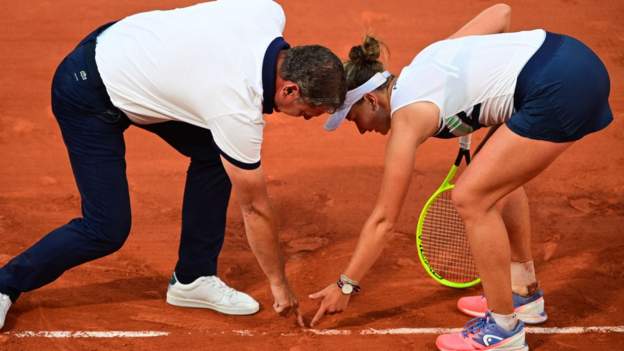
Seeing a chair umpire jump down to the court, scamper across the clay and point out the mark of a ball is one of the great traditions of the French Open.
The scene adds to the spectacle. A sense of anticipation hangs in the air, whistles or cheers from the Paris crowd - depending who the decision is for - accompany the official to the spot.
But, in a sport of high stakes and fine margins, is it time to stop relying solely on the human eye to decide crucial points?
At the recent Italian Open, Britain's Andy Murray was annoyed when a line call went against him because the umpire ruled the ball mark was on the line.
Murray strongly disagreed. Electronic line calling technology - not used at the Rome tournament but seen by television viewers - supported the former world number one's view.
The incident reignited a long-running debate whether an electronic system should be brought on to all courts - including Roland Garros' famous terracotta surfaces.
Is the technology unreliable on clay?
Unlike the other three Grand Slam tournaments, which are played on hard or grass courts, the French Open does not use the technology in any form.
The Australian Open and US Open - both played on hard courts - have already dispensed with human line judges in favour of solely relying on automated calls.
Wimbledon, played on grass, introduced Hawk-Eye technology in 2007 but the line judges remain. Players at the Championships are able to challenge calls up to three times per set.
The French Open continues to fully trust line judges and umpires, not allowing players to use electronic replays to challenge human decision.
For a long time it has been felt the red brick dust - a top layer of one to two millimetres - compromises the accuracy and reliability of an electronic system because it is a 'live' surface which moves during the match.
That has led to continuing issues of confidence from players, commentators and fans.
But Foxtenn - one of three systems used to judge line calls in tennis, alongside Hawk-Eye and IMG Arena - insists it is reliable.
Foxtenn is the only vendor which has so far operated an electronic line calling system on clay courts.
It says its 'real bounce technology' - which uses ultra-high-speed cameras capable of generating more than 100,000 images per second in combination with a laser scanner system - is suitable for the surface.
"It delivers perfect and constant real-time calibration," say the Barcelona-based company.
"It basically catches everything that happens on the court; anywhere from minute detail to every unthinkable angle."
Why doesn't the French Open use it?
Last month, the ATP Tour - the top tier of men's events - announced line judges will be replaced by an electronic calling system on all surfaces on a full-time basis from 2025.
The WTA, the governing body of women's tennis, told BBC Sport it has "been reviewing" going full-time with electronic line calling and is "very interested" in making a similar move to the ATP.
Remy Azemar, the French Open's head of referees, acknowledges the technology has been successful at other tournaments.
Yet the resistance remains firm.
Two factors fuel the French Open's reluctance to change: maintaining traditions synonymous with the 100-year-old tournament and an unwillingness to cede human control.
"Without the presence of the line judge, it is indeed very robotic," said Azemar. "But we must also recognise that it works.
"Will it make the game look a bit colder and emptier on the court? Everyone can have an opinion on that, it's not for me to answer."
France is widely considered one of the strongest nations when it comes to developing officials and Azemar says Roland Garros has "nothing to prove" in terms of its quality of officiating.
"As long as the human referee remains in charge, we are a little less directly concerned. We keep the freedom to make our decisions," he said.
Will we ever see it at Roland Garros?
With an increasing number of tournaments relying on electronic line calling, the French Open is fast becoming an outlier by sticking with tradition.
Foxtenn and Hawk-Eye have already been approved as a review system on clay with line judges, with Foxtenn being used at ATP events in Barcelona, Estoril, Madrid and Bastad last year.
No vendor has yet been approved to make sole decisions without the officials. Final testing of the automatic technology on clay is continuing.
The ATP, the men's governing body, said its impending move will "optimise accuracy and consistency across tournaments, match courts and surfaces".
Last season, there were 30 WTA events which used electronic line calling - including 13 that did not have line umpires.
Only two WTA clay-court events - Madrid and Iasi - used an electronic line calling review system in 2022.
With an even heavier reliance on the technology on the horizon, Azemar conceded the French Open could be forced into change.
"If 98% or 99% of the tournaments in the season are played without line judges, we will be backed into a corner," he said.
"I think we have to weigh things up carefully and give ourselves time. But we can also be caught up by reality."
What disputes have there been recently?
Disputes over line calls are regular occurrences during the European clay-court season and there were a number of notable examples during the recent Italian Open.
Murray's disagreement with Mohamed Lahyani in Rome blew up because of the three-time major champion's huge profile - and his heated reaction.
Lahyani was also involved in another similar incident in Rome. The Swedish umpire made a decision that left Danish player Holger Rune furious in a quarter-final against Novak Djokovic, which he eventually won.
Rune questioned whether officials were punished for "mistakes", as did Russia's Veronika Kudermetova who remonstrated with the chair umpire in her quarter-final.
At the French Open, there was a high-profile incident in 2021 that could have had even more damaging consequences.
In a dramatic semi-final against Greece's Maria Sakkari, Czech player Barbora Krejcikova was denied victory when chair umpire Pierre Bacchi overruled a call from a line judge on match point.
Television replays indicated the ball was out, leading Murray - watching on the television - to say Bacchi had made an "absolutely brutal error".
Krejcikova brushed off the disappointment, took another match point and won her maiden Grand Slam singles title two days later.
These disputes illustrate the confusion which still remains around clay-court marks. Whether the wrong mark has been checked, or the mark is not a true representation because of physics, tension can be created as a result.
"I don't mind that it's like this with line umpires judging," said Rune. "But it's about how you read the mark. Sometimes it is wrong."
Until the governing bodies are satisfied the technology is more accurate than the human eye, the drama over disputes will continue - perhaps over the next weeks at Roland Garros.
PSA players welcome chance to receive ‘the recognition we deserve’
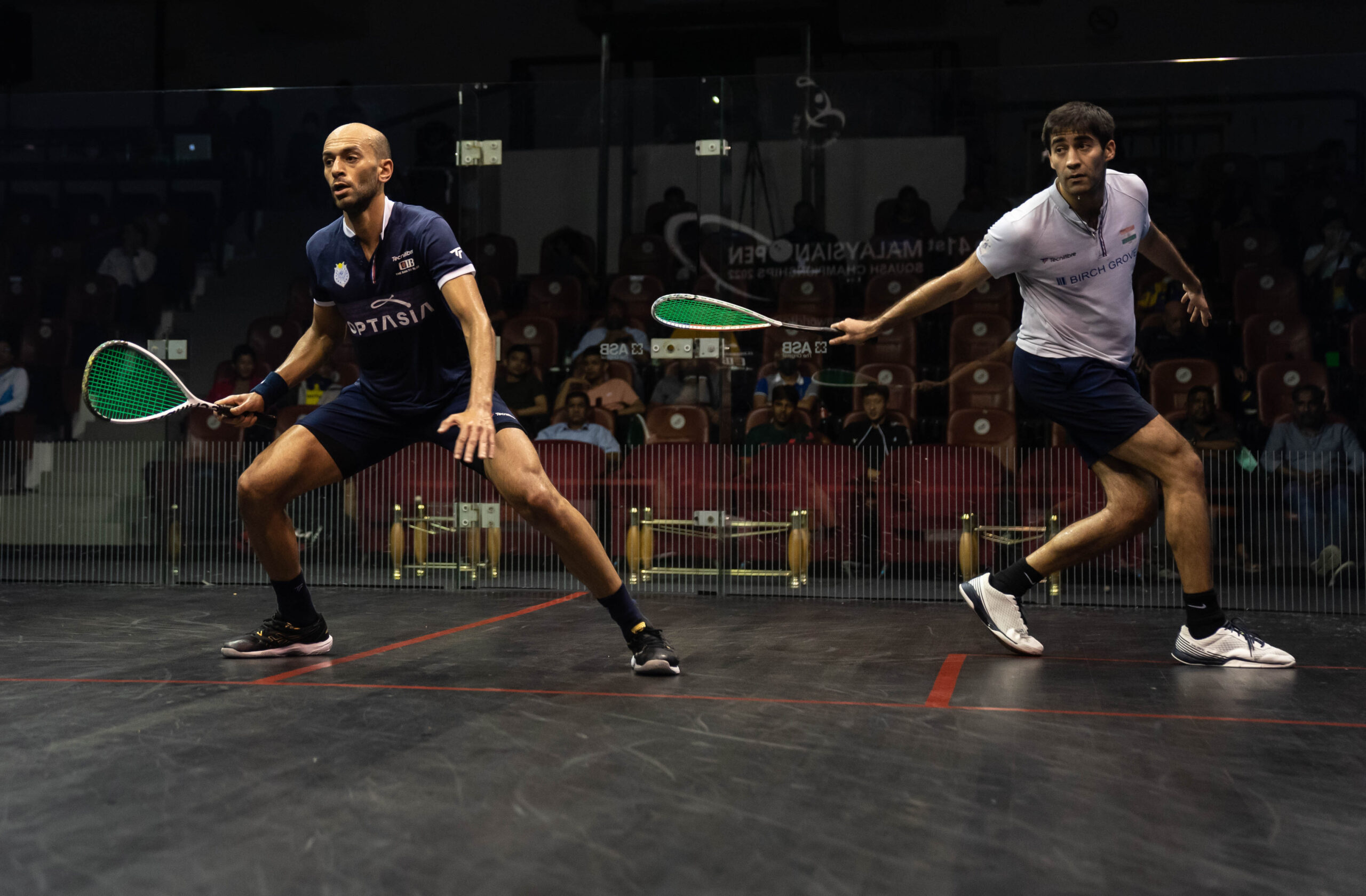
PSA World Tour players have united in their praise and gratitude after billionaire businessman Mark Walter’s “game changing” investment into professional squash.
Walter, who is co-owner of Chelsea FC and the LA Dodgers, has acquired a stake in Squash Media and Marketing (SMM), the commercial arm of the PSA.
The additional funding will be used to increase marketing of the sport and the PSA’s athletes, develop new digital products and services for squash fans worldwide and ramp up the creation and distribution of engaging content.
Walter, who’s already a squash benefactor after bankrolling the last three World Championships in Chicago and the Windy City Open since 2015, said he wants to make squash “a broader and more inclusive sport and to bring it to more fans.”
That is music to the ears of current players, particularly those outside the top 10 for whom the financial rewards of being a touring professional are currently modest.
As a former Wall Street banker, India’s world No.37 Ramit Tandon has greater insights into the world of investment than most squash players.
He told Squash Mad: “This is a big step for the PSA to have someone with his [Walter’s] expertise and resources on board and it’s something I believe the Tour needs. With this I see a lot more merger opportunities, sponsors and investors coming to the table.
“It’s also an achievement for the PSA and the players to be valued highly and get the recognition we feel we deserve.
“As an entity with Mark coming on board I definitely feel we have raised our value and I’m sure this will push our sport in the right direction from a financial and marketing standpoint.”
England’s world No.7 and Commonwealth Games women’s singles gold medallist, Gina Kennedy, echoed Tandon’s positive vibes.
“I think the new investment is absolutely amazing news,” the 26-year-old told us. “I am really excited to see the impact that it will have on the tour next season.
“I feel very fortunate to be an active PSA member at this exciting time and I have to applaud the PSA for securing this deal.
“The pro players will clearly benefit from seeing an increased amount of prize money and number of tournaments, which is a huge step for us as professional athletes. Hopefully the investment can help increase the popularity of the sport too.”
USA No.1 Amanda Sobhy tweeted: “Fantastic news for the sport and PSA World Tour! The Walter family have always been so supportive with the Windy City Open and World Champs, so it’s great to see him investing in Squash media & Marketing to help elevate our sport even more! Good things to come!”
France’s Victor Crouin had his say:
This is great news for our sport! Looking forward to seeing first-hand the impact this investment will have on the PSA Tour over the next few years ? https://t.co/wCBd9ieFHP
— Victor CROUIN (@VCrouin) May 23, 2023
And Egypt’s Marwan ElShorbagy commented: “Thanks to the Walter family for the continued support to our sport [and] all credit to the PSA World Tour for getting this deal done!”
Newcastle Falcons: Gary Graham & Micky Young among 15 players departing
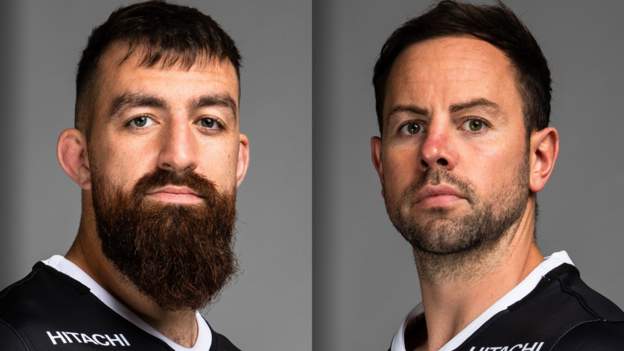
Scotland back-rower Gary Graham, scrum-half Micky Young, lock Greg Peterson and prop Logovi'i Mulipola are among 15 players to leave Newcastle Falcons.
Young, 34, racked up 200 appearances for the Falcons, and will now retire.
Graham, 30, played 95 games and attracted England attention before switching allegiance to Scotland.
United States international Peterson, 32, featured 75 times, while Samoa's Mulipola, 36, played 79 matches across his five seasons at Kingston Park.
Homegrown lock Sean Robinson, after 135 games for the club, will also be leaving, as will former Sale and Bath back-rower Carl Fearns after two years at Kingston Park.
Full-back Alex Tait and back-rower Will Welch had already confirmed their retirements.
Conrad Cade, Connor Collett, Matthew Dalton, Conor Kenny, Pete Lucock, Tom Marshall and Cameron Nordli-Kelemeti complete the list of departures.
Alun Wyn Jones: Wales legend to captain Barbarians after announcing international retirement
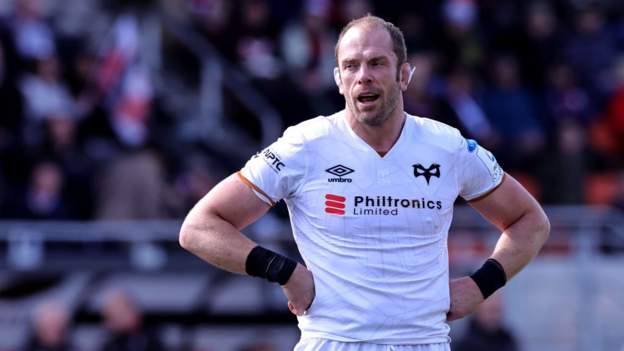
Alun Wyn Jones will captain the Barbarians against the World XV at Twickenham after announcing his international retirement.
Israel Folau starts on the wing for the World XV, who are skippered by Italy's Michele Lamaro.
Steve Hansen is coaching the World XV while ex-England coach Eddie Jones takes charge of the Barbarians.
It will be the first time Jones has returned to Twickenham since he was sacked in December.
The Rugby Football Union (RFU) will be flying a Pride flag at Twickenham this Sunday (14:00 BST) and Hansen has welcomed the decision, saying the stance is a "positive consequence" of Folau's selection.
Folau, 34, was sacked by Rugby Australia in 2019 for making anti-gay comments on social media.
The two teams are invitational, meaning the coaches select players from any country to participate. The game is not a Test match as, while it is played at Test level, no caps are awarded.
In a statement released on Wednesday, the RFU said it "supports the LGBTQ+ community" and understands if they "feel unwelcome" and "disheartened by the appeared acceptance of anti-LGBTQ+ viewpoints on the pitch".
It said the RFU is "challenging, and will continue to challenge, exclusionary behaviour and micro aggressions to ensure everyone feels respected, empowered and accountable".
Team line-ups
Barbarians: Anscombe; Radwan, Tamanivalu, Kerevi, Li; Cooper, Maunder; Waller, Dolly, Pieretto, AW Jones (captain), Lewies, Wainwright, Yamamoto, Luatua.
Replacements: Thacker, West, Sadie, Simmons, Vailanu, Hougaard, Cruden, Johnson.
World XV: Piutau; Folau, Radradra, Laumape, Nkosi; Hastings, Phipps; W Jones, Brown, Kebble, Ratuniyarawa, Hockings, Negri, Lamaro (captain), Mata.
Replacements: Dee, Dell, Street, N Cannone, Murphy, Hall, Patchell, Rasaku.
United Rugby Championship exploring draft system to improve competition
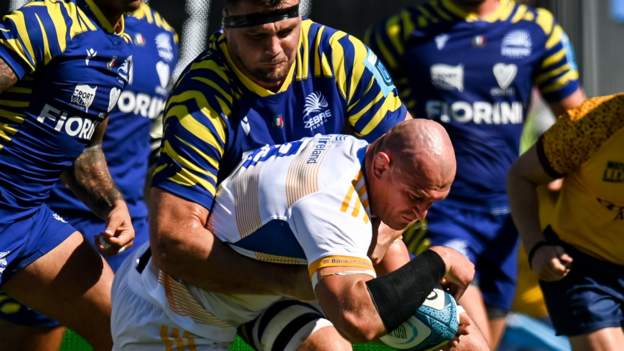
The United Rugby Championship is exploring a form of draft system to improve competitiveness across the league.
Italian side Zebre lost all 18 games this season as they finished bottom of the table in consecutive seasons.
Leinster topped the table after the regular season and only lost twice - including the semi-final to Munster.
Chief executive Martin Anayi says the URC needs to "think laterally" about improving the weaker teams' standards.
"There might be an ability to draft in players from the other unions who aren't getting game time," he told BBC 5 Live. "That is 100% [a conversation]."
One of the biggest defeats Zebre suffered this season came at the hands of the Bulls, who beat them 78-12. The Dragons, who finished second from bottom, only managed to win four games from 18.
Anayi says a lack of jeopardy at the bottom of the table is a result of a "closed league", one without promotion and relegation.
"There is a natural filter system to relegation, one team goes down and the team that comes up is full of expectation because they have won the league below; we don't have that in a closed league," he added.
"Our job is to find ways of helping the likes of Zebre and the Italian Federation to make them more competitive.
"In American sports they have a system for doing that, the draft system. We don't have that, so we need to think a bit more laterally about that question.
"Ireland have so much talent they are trying to work out how does everybody get game-time, while Scotland have two teams so that creates a bottleneck for them.
"So those are avenues we are trying to explore. We are setting up a high-performance think-tank to help us with that question, from a league-wide point of view.
"Zebre has been at the bottom of our table for a wee while and we need to try and do something to help them."
Anayi says there is enough collaboration to ensure a draft system could work, without concerns from other unions about improving rival teams.
"We have that collaboration at union level. They see the league is better and more commercially viable if all the teams are competitive," he added.
"And secondly they want the Six Nations to be competitive. Our unions can see that helping Zebre is a good thing both for the league and also for the Six Nations."
'League needs different winners'
Leinster have dominated the league in recent years, winning four titles in row between 2018 and 2021, but that monopoly has been broken over the past two seasons.
While the Dublin-based team only lost once in the regular campaign, they were beaten in the semi-final by Munster, a year on from losing a last-four meeting against Bulls.
"They have been beaten twice in play-off format in the URC, and that's what we need, not for Leinster to be beaten, but to have jeopardy," Anayi added.
"We are going to have a team that isn't Leinster winning it [for the last] two years, after they won the previous four.
"I think it's good to see a different name on the trophy each year."
Stormers host Munster in this year's showpiece, in front of a sell-out crowd in Cape Town, with Anayi praising the impact of the South African franchises on and off the field.
"They have just been great for the tournament," he said.
"And it's built in South Africa too. [At first] they didn't know what URC was, they didn't know what the Champions Cup or the Challenge Cup was, but we've seen the Stormers build from 20,000 [attendances], to 30,000, through 40,000 and now we have got our first sell-out of 57,000.
"It's been an amazing couple of years."
How Sergei Bobrovsky transformed into a 'special' playoff goaltender for the Panthers
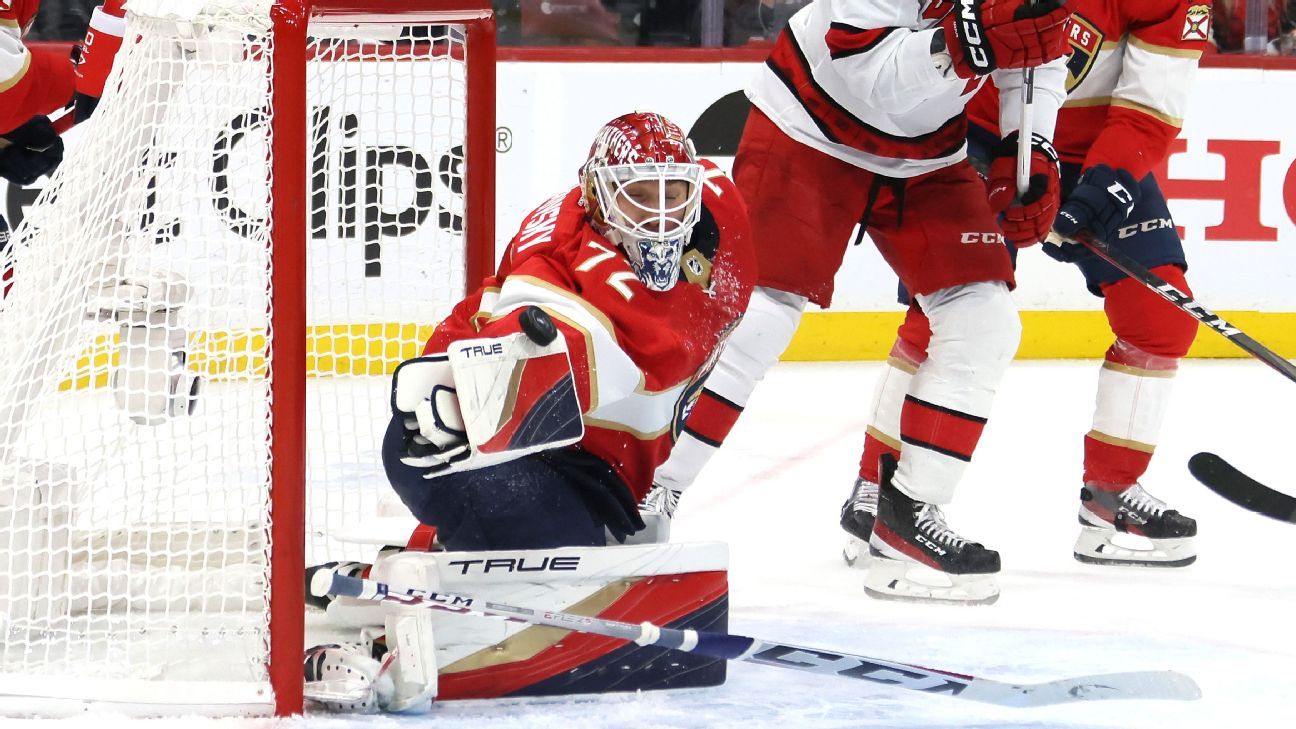
SUNRISE, Florida -- Legend has it a cat possesses nine lives, and always lands on its feet.
Florida Panthers' goaltender Sergei Bobrovsky seems to have taken those myths to heart.
Like the creature emblazoned on the crest of his sweater, the 34-year-old Bobrovsky has survived -- and eventually thrived -- through a tumultuous NHL season. In the previous eight months, Bobrovsky has been maligned and lionized, built up and counted out, a No. 1 starter and secondary afterthought.
Through it all, Bobrovsky was saving his best work for this moment, as the Panthers' postseason hero. Florida is up 3-0 on the Carolina Hurricanes in the Eastern Conference final, one win away from the franchise's second Stanley Cup Final appearance, with Game 4 tonight (8 p.m. ET, TNT). Bobrovsky already has the inside track on a Conn Smythe trophy win: 10-2 postseason record, .935 save percentage. 2.15 goals-against average. One shutout. Even one assist.
It's not how Florida drew things up, of course. That would hardly befit the journey Bobrovsky -- or the Panthers themselves -- have taken this season.
Florida battled its way into clinching a playoff berth in the final week, turning an abysmal 18-19-4 start into a late-season crescendo capturing the Eastern Conference's final spot. The Panthers pulled off a blockbuster summer trade for Matthew Tkachuk, saw him put together a 109-point, Hart Trophy-nominated regular season, and kept the faith that Florida's other stars would eventually catch up.
Bobrovsky reappeared right at the time he could have been written off.
When the Panthers started their unlikely playoff run, Alex Lyon had usurped Bobrovsky -- felled by illness late in the regular season -- as Florida's go-to goaltender. It took Lyon faltering in the Panthers' first-round series against the Boston Bruins for Bobrovsky to get another look. No one's checked the rearview mirror since -- least of all Lyon.
The journeyman might play behind Bobrovsky now, but Lyon has had a front-row seat at Bobrovsky's master class of preparation -- one allowing the veteran to ace these playoffs.
"It's like a writer being in a room with Ernest Hemingway," Lyon said of watching Bobrovsky work. "For me to be able to see him operate on a daily basis, that's literally like striking gold."
IT'S NOT EXACTLY an investment of precious metals, but Bobrovsky's $10 million annual salary is the richest backing for any active NHL netminder. The Panthers have been waiting on that stock to mature.
Before landing in South Florida, Bobrovsky was backstopping the Columbus Blue Jackets and cementing his name as one of the league's top goaltenders, with two Vezina Trophy wins (in 2012-13 and 2016-17). When Bobrovsky hit free agency on July 1, 2019, the Panthers swooped in with a seven-year, $70 million contract offer to theoretically cement Bobrovsky, then 31, as the team's starter for the remainder of his career.
The road since has been riddled with speed bumps. This season was no exception.
Bobrovsky started out poorly, producing a 12-13-2 record with .897 SV% and 3.24 GAA through mid-January when he was placed on injured reserve with a lower-body issue. Time away clearly did Bobrovsky some good; he returned in February and went on a 12-4-1 run, with a .915 SV% and 2.54 GAA.
Skidding out of March with three straight losses led to a long illness for Bobrovsky, a stretch where Florida turned back to Lyon (Florida's other netminder, Spencer Knight, had by then entered the NHL's Player Assistance Program). It was Lyon who subsequently led the Panthers to six straight wins and helped propel them into that final playoff spot.
It was an improbable scenario playing out in the Panthers' favor, led by a goaltender with all of 24 NHL games under his belt going into this season. Florida coach Paul Maurice chose to ride that hot hand into the Panthers' first-round matchup against Boston, the Presidents' Trophy winners who had a record-setting 65-win, 135-point campaign.
Lyon was 1-1 in the series' first two games. When Florida trailed 4-0 in Game 3, Lyon got the hook. Bobrovsky was back in. He went on to start Game 4 and was rusty in a 25-save performance, but Maurice stuck with him. Once Bobrovsky found his groove it was like turning back a clock to those Vezina-winning days. And Bobrovsky has only gotten better.
He capped off the Bruins' series with three straight wins to send Florida into the second round. Bobrovsky dominated that next series against the Toronto Maple Leafs at 4-1-0, with a .943 SV% and 1.89 GAA as the Panthers bid adieu to the Leafs in five games.
Somehow, Bobrovsky has improved further taking on Carolina in the conference final. Florida jumped out to a 3-0 series lead with Bobrovsky stopping 132 of 135 shots, and he hasn't allowed a goal since the opening two minutes of Game 2. Not one of the Hurricanes' forwards have scored an even-strength goal. And it was Bobrovsky's first playoff shutout that powered Florida to an electrifying 1-0 win in Game 3 where they were outshot, 32-17.
If you thought Bobrovsky would accept some credit for the feat, you'd be wrong.
"It's a team structure, how we play," a deflective Bobrovsky said of his showing in Game 3. "My teammates allow me to play good. The structure and how hard they work in the defensive zone to get that result and to win, it's not easy for some players to get that role and block shots and sacrifice their stats for that. Our guys have sacrificed themselves for the team result and it's happy to see."
That good-natured energy, that ability to stay humble and focused, is what's stood out to Bobrovsky's teammates all along. Regardless of what the outside world had to say, Bobrovsky didn't let past performance determine his future potential.
"I think that's what's so great about Bob," defenseman Brandon Montour said. "People see him as having come to Florida and maybe not performing as well as he used to. But his mindset, his attitude, the way he comes to the rink every day, win or lose, he's the same guy, [brings] the same stuff. So it's great that he's [on] his game, but I feel like in our locker room, we don't notice much difference. He's been the same, worked hard, goes about his business and he's doing it the right way."
Anyone searching for insight into how exactly Bobrovsky's been such a dynamo will have to keep looking -- because he's not telling. It's not for strategy's sake. Bobrovsky just doesn't want to dwell on his own success.
"It's a team effort," he said of Florida's run. "It feels in a game like you just play in the moment. There's no future, no past, you're just right here, right now. You see what's going on and you react accordingly. Everyone contribute[s] to the result. It is what it is. I'm fortunate and humble and thank God for this."
IT WOULD BE EASY for Lyon to resent Bobrovsky.
After a career spent mostly bouncing around the American Hockey League, Lyon was finally experiencing long-awaited NHL success. How frustrating then that right when Lyon stumbled, Bobrovsky suddenly hit his stride. A missed opportunity? Not for the 30-year-old Lyon. It was more a chance to study with his partner.
"I think when you're a young hockey player, you get caught in the trap of, 'What's the one thing that I can do? What's the secret that's going to elevate me to Vezina status?'" Lyon mused. "And it's just a very unhealthy way to think. You can fall into that trap. There's not one thing that's going to make you get over the top.
"It's just about your body of work, showing up consistently, doing the right things on a daily basis. And Bob's the model of that. For me to just be able to pick and choose what I like and see what works for me, try different things, be around him, it's great. I'm a learner. I like to learn by process."
Bobrovsky has certainly been schooling Carolina.
The Hurricanes pelted Florida from every angle in Game 3. They had breakaway tries. Plays off the rush. Hard shifts spent cycling in the Panthers' end that obviously put Florida's skaters on their heels.
It was Bobrovsky who kept standing tall.
"[Top goaltenders] can do that when they're on a stretch like this," Carolina coach Rod Brind'Amour said. "You're coming home [after a game] and you just say, 'I could have four or five.' That didn't happen [for us]. It it what it is; he's playing great."
If he weren't, Maurice felt it unlikely that Florida would even be in its current position.
"It's a piece of the teams get to the [conference final]," he said. "We're coming in as a wild-card seed; it's almost a prerequisite the goalie comes in and is special this time of year."
While Bobrovsky has garnered individual accolades before, this is the closest he's come in a 13-year career to reaching a Cup Final. Florida went there in 1996. A victory in Game 4 would bring the Panthers back.
If that comes about it will be for a dozen different reasons. None are more paramount than how Bobrovsky has stepped up to star in a Cinderella season.
"It makes me excited, it makes me appreciate it," Bobrovsky said of being so close to the Cup Final. "I feel good. I'm just enjoying the opportunity and I want to thank God for this position and this game."
The power of positive coaching and its impact on the Stanley Cup playoffs
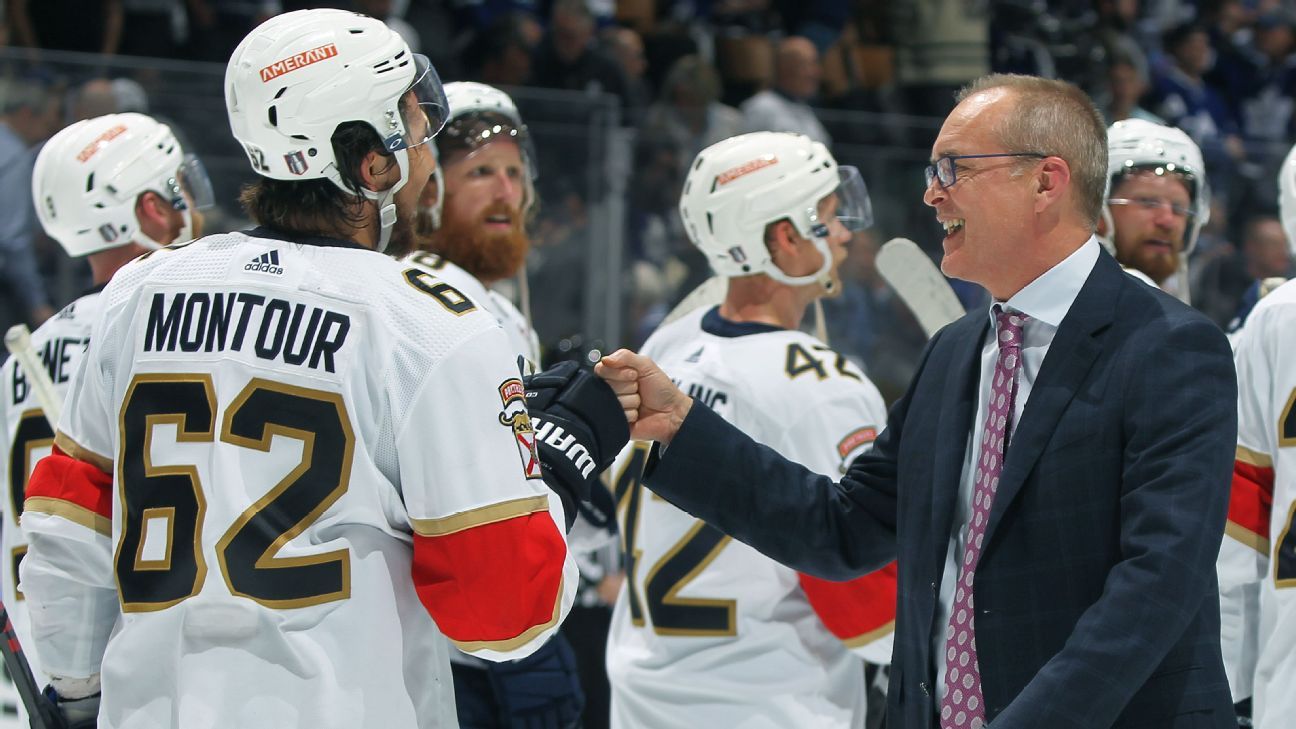
Following one of his nine seasons coaching the Winnipeg Jets, Paul Maurice had an idea: Could he be more intentional about the video he showed his players?
Video sessions are one of the most common teaching tools coaches employ. Maurice, now coach of the Florida Panthers, the eighth-seeded darlings of the Stanley Cup playoffs who are one win away from the Cup Final, wondered how his staff could maximize these meetings. How many times did they have to show a system before it appeared in a game? Could they identify lag time from a teaching moment on video to tangible success on the ice?
Maurice also wanted to quantify something deeper: Was his clip selection affecting players' psyche and performance?
"What happens if we put the same player on all of our negative clips, even though I know it's not all on that one player, like I'm picking on him? Or if I kept showing a player just doing good things, because I love that player?" Maurice said. "We wanted to find the cumulative effect of the video we were showing."
So Maurice and his staff embarked on an offseason project.
"From Monday to Thursday, the whole summer, from 9 in the morning to 1 or 2 in the afternoon, we all got together and reviewed everything," said Pascal Vincent, then one of Maurice's Winnipeg assistants. "We were looking for ways to improve."
The Jets' staff charted videos they showed the team the previous season and tracked the results in the subsequent games. They labeled each clip in one of three categories: positive clip, teaching clip, negative clip. The analytics department took it from there.
As the data accumulated, the coaches couldn't help but notice a pattern.
"We realized that we were getting results and seeing more success when we were showing more positive clips," Vincent said. "Of course, there are many other variables, but that is what the data said. I've done a lot of reading on the topic across other walks of life, and it confirmed what I was feeling."
The feeling has become a massive trend in the NHL: Coaches are finding that it's more productive to build up confidence through encouragement rather than hitting players with constant criticism. And it's especially true with young millennials and Generation Z.
"The bully coach, right, wrong or different, has no chance in today's game," Detroit Red Wings coach Derek Lalonde said. "It's the reality of the players today. You still have to hold them accountable, but you have to do it in different ways."
Call it the Ted Lasso effect. Heck, NHL players are even quoting the fictional soccer coach, known for his extremely upbeat attitude. Bruins goalie Linus Ullmark committed a puck-handling blunder in overtime of Game 5 of Boston's first-round series, directly leading to Matthew Tkachuk's winning goal for Florida. Afterward, Ullmark met a scrum of reporters and cameras at his locker, relaxed, composed, and even smiled at times. "You just have to have the mind of a goldfish," Ullmark said, a verbatim quote from the TV series.
The popular show is a microcosm for a shift in societal norms, which includes a new emphasis on mental health. Workplaces across multiple industries are adapting as younger generations crave different -- and in many instances, less negative -- environments than their predecessors. Historically, that contrasted with the high-pressure, demanding nature of professional sports. Not anymore.
"Positive, constructive feedback -- maybe people needed it generations before as well," said Bruins forward Garnet Hathaway, 31. "It just wasn't mainstream or they didn't advocate for it. But now, you see it as a way of unlocking even more potential."
The change in the sport is noticeable, and it's leading to periods of self-reflection.
"Overall it's become a more conservative, sensitive world. Kids now grow up not being yelled at, so they don't know how to react to being yelled at," Colorado Avalanche forward Evan Rodrigues, 29, said. "Growing up, I loved to be yelled at, it got me into the game, it got me focused. Now when someone yells at me, I take it differently. I'd rather them come up to me and say, 'Hey, I know you're better than that.' I used to love proving people wrong whereas now I like proving people right."
That idea feeds into one of Vincent's tried and true teaching techniques.
"Even if a player is struggling, there's a reason that they're here [in the NHL]," said Vincent, who this season served as an assistant coach for the Columbus Blue Jackets, one of the youngest teams in the league. "So you need to find out what that player is good at, then reinforce it. When you lose your confidence, you go back to the foundations of what you're good at, and it helps them find it again."
Many players interviewed for this article pushed back on the idea that coaching has to be all positivity all the time -- or that the NHL has fully transformed.
One player on an Eastern Conference team said: "My coach reads me the riot act pretty much twice a week. And I'm fine with it, if I deserve it."
Another player described a "passive aggressive" style from one of his former coaches, who is still behind an NHL bench. "He'd say mean things about you loudly, while you were in earshot so you can hear it," the player said. "Obviously because he wanted you to hear it."
Some in the league see a downside to the uber-positive approach. After the Maple Leafs' disappointing second-round loss to the Panthers, a narrative emerged in some circles that Toronto management created an environment where its star players were too coddled, and therefore ill-equipped to handle the adversity of playoff hockey.
One longtime veteran player in the league said he has noticed a gradual change over the past few years and "it doesn't sit well with me."
"Not to be the 'back in my day' guy, but ... it really feels like we've become softer as a league," the player said. "There are some dinosaur practices that need to go. I'd never advocate for mental or physical abuse. But this is professional sports, and it demands a level of accountability and toughness. It's OK to feel uncomfortable sometimes. It's OK to be yelled at or called out when you're not meeting standards. That's what makes you stronger."
Former player Ray Ferraro, an 18-year NHL veteran and current ESPN analyst, put it bluntly: "Sometimes you need to be demanding, but not an a--hole. Because the old way certainly doesn't work."
Avalanche forward Mikko Rantanen, 26, called himself "a younger guy," but said, "I don't mind negative [coaching] sometimes."
"I think the positive way of seeing is better, but it can't be all positive; it needs to be a balance," Rantanen said. "[Colorado coach] Jared [Bednar] does a good job of that. When we don't play well, he shows it. Even when there's a game where we fall asleep just for a few plays, he's going to show it the next day and be mad. And that's the way it should be."
After Game 1 of the Western Conference finals, Dallas Stars coach Peter DeBoer said he laid into his players a bit following their loss to the Vegas Golden Knights.
"There's certain pressure points with your team that you have to decide as a coach," DeBoer said. "Is this a time to be supportive and a calming voice of reason, or is this a time to turn the screws and get into them a little bit? I think you can only go to the latter one so often."
Coaches have also adapted to another trend younger millennials and Generation Z covet: transparency. Younger players don't need to agree with what is happening, they just want to know why. Bednar said he has adapted by being clearer with communication.
"The trend, and it makes sense to me now, is that if guys get no information, they'll go to the negative thought process," Bednar said. "I always thought if I don't give feedback on something, then you know you're doing good. I like my guys to know that: If I'm not coming to you, it's a good thing."
But over the past few seasons, Bednar noticed that approach wasn't always working, especially with younger players. If players didn't receive any reaction from him, they'd assume the worst, or look to other places for feedback, such as social media, which can get dicey.
"If a guy plays 10 minutes a night generally, then all of the sudden he has a game that's 7½, he'll be like, 'Oh my God, what did I do wrong?' Then the negative thoughts come in," Bednar said. "So I try to interrupt that. You have to go out of your way more. Now I try to brush past them in the locker room and just say, 'Hey, good job last night,' so they have something, even if I'm not having meetings with them."
Lalonde said he has made transparency a top priority for the Red Wings.
"I've never had a lineup go up until I told the player he's not in, and exactly why," Lalonde said. "You have to be honest."
Lalonde cited an example this season of a game in which he scratched one of his forwards.
"We spent just as much time as a staff putting three or four points together for the guy not in the lineup as we did on game planning the next night," he said.
Maurice still thinks back to his tape study but isn't ready to draw any grand conclusions.
"I don't know if there's a solid theory for every team," Maurice said. "Every team is different, every player is different. The most important thing is to understand the human nature aspect of it all."
Josh Tongue added to England men's Test squad to face Ireland
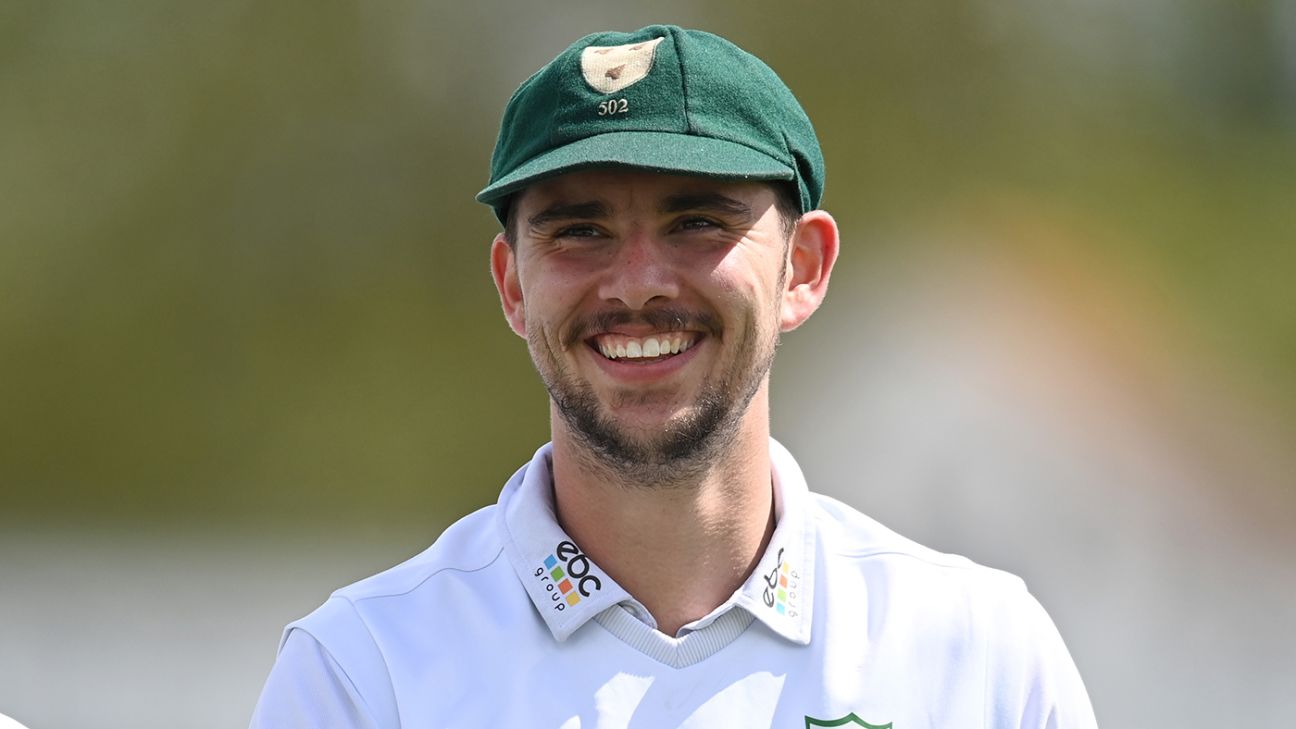
County directors call for 'urgent' review into standard contracts amid franchise exodus
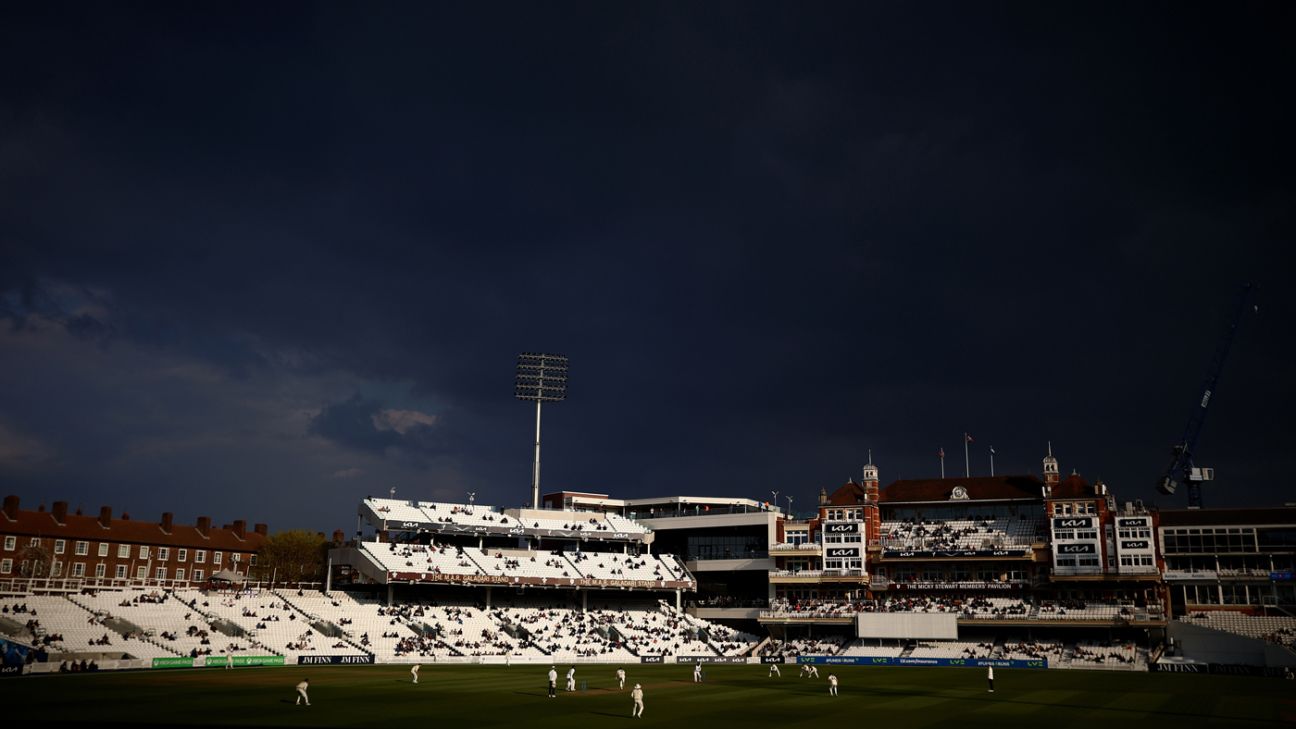
The directors of cricket (DoCs) at county clubs have called for an "urgent" review into standard contracts to address the "very real challenge" presented by their players representing several franchises during the English winter.
The majority of county cricketers are employed on 12-month contracts but the English season only runs from April to September, meaning that an ever-growing number of players are travelling overseas during the off-season to play in franchise tournaments.
"They go away and play elsewhere and when they come back they want time in the indoor centre, the benefit of the best coaches advising them on their game, just to get ready to go off and play in another franchise competition somewhere else," Stewart told Sky Sports earlier this month. "'Oh and by the way, I've got a little injury so can I get treated by the physio, the doctor, the medical staff and can I get rehab as well?'"
The DoCs met at The Oval on Monday and have since circulated a statement calling for representation on "any future performance committees or other appropriate working groups" so that the English game can "take advantage of our many years of amassed experience".
On the issue of player contracts, the statement said: "The current arrangement leaves the clubs with little control over their players' movements in the off-season, often leading to increased medical and staffing costs to ensure players are suitably prepared and rehabilitated, and there is clearly now the need for more flexibility in this area to suit both clubs and players.
"The number of players involved in winter tournaments has risen exponentially in the last four-five years and with the US Major League on the horizon, this is becoming a very real challenge for all involved. The group understands that the ECB, PCA and county CEOs also recognise the need for this review, and we would welcome the opportunity to have a direct input into these discussions."
A number of players are already on white-ball-only deals with counties, but the Professional Cricketers' Association (PCA) has warned that contracting more players only for specific windows will present "a real risk" to the sport. "It will create more white-ball specialists and could have a detrimental effect on the red-ball game and the Test team," Daryl Mitchell, the PCA's COO, told the Guardian. "And the men's Test team is what underpins the [English] game's finances.
"Take away the care package of coaching and medical support and it becomes very transactional. Players love having a 'home', but strip away those benefits and the big career decisions become easier for players - in the wrong direction.
"I understand the frustrations of the counties and players need to respect that side of it. We're also very aware the global landscape has evolved and contracts need to evolve with it. But I don't think contracting guys for six to eight weeks for specific competitions is the way to go. We have to protect the pathway."
Did Dhoni deliberately waste time to let Pathirana bowl against Titans?
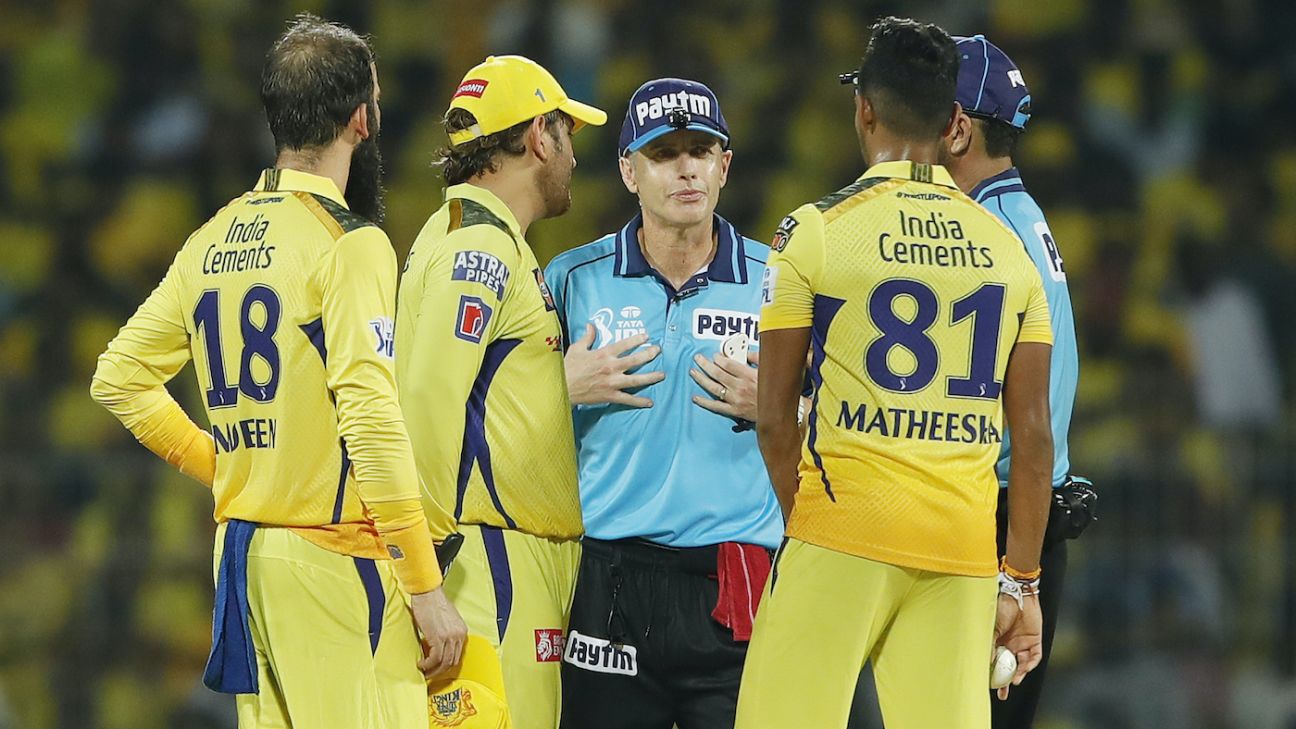
According to the IPL playing conditions, a player who leaves the field to treat an internal injury - or for any other reason - for more than eight minutes needs to be on the field for a similar duration on his return before he is allowed to bowl. It could not be confirmed what niggle, if any, Pathirana had when he left the field. A query with CSK to check on the reason Pathirana left the field has so far gone unanswered.
He had delivered his first over - the 12th - which went for ten runs, including four wides. At some point after that, he left the field. On his return, he was tasked with bowling the 16th over. Titans, at the stage, were 102 for 6, needing a further 71 runs for victory.
ESPNcricinfo has learned that the match officials informed Dhoni at that point that Pathirana had to wait a few more minutes before he could bowl again. Dhoni, it is understood, acknowledged the playing conditions, but argued that he had no option but to bowl Pathirana.
His three other frontline bowling options - Ravindra Jadeja, Maheesh Theekshana and Deepak Chahar - had completed their four overs. Only Tushar Deshpande had two overs left apart from Pathirana's three. Moeen Ali, the only other bowling option, had not bowled at all, and it is learned that Dhoni told the umpires that he couldn't afford to bowl an offspinner against the two right-hand batters - Vijay Shankar and Rashid Khan - in the middle.
The minutes ticked by. Dhoni was reminded that he and CSK stood to incur both the financial penalty for a slow over-rate and the in-match penalty of having only four fielders outside the 30-yard circle if the 20th over did not begin by the designated cut-off time. It is understood that the Titans' batters, too, checked with the match officials about the delay.
Eventually, Pathirana was allowed to bowl, after four minutes of discussions between Dhoni and the umpires, which took care of the time he was out for. He gave away 13 runs in his second over, then picked Vijay Shankar's wicket in his next over, which went for four runs and also saw Darshan Nalkande run out.
The delay ended up not hurting CSK financially, though they suffered the in-match penalty having started the 20tth over after the cut-off time.
The question remains as to whether the umpires considered penalising CSK under the unfair-play law, Law 41.9, which concerns time-wasting by the fielding side. As per this rule, the umpires have to issue a first and final warning to the fielding captain if they feel there is deliberate time-wasting during the course of an over. A repeat of the same offence will result in the batting side being awarded five penalty runs and the bowler being suspended. Enforcing the time-wasting rule, though, is left entirely to the discretion of the umpires.
There remains the possibility that other teams will look at this incident and it could become something of a trend in the future.
Nagraj Gollapudi is news editor at ESPNcricinfo













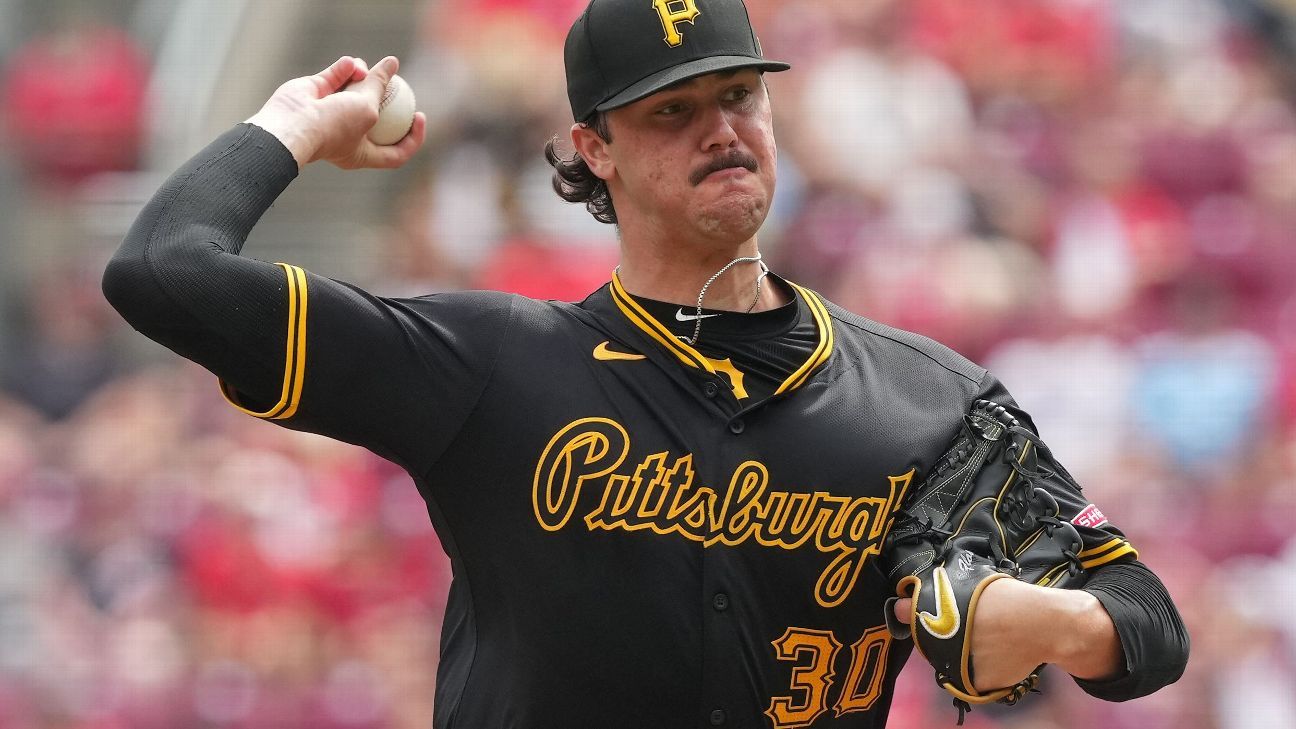

 Phone: (800) 737. 6040
Phone: (800) 737. 6040 Fax: (800) 825 5558
Fax: (800) 825 5558 Website:
Website:  Email:
Email: 






